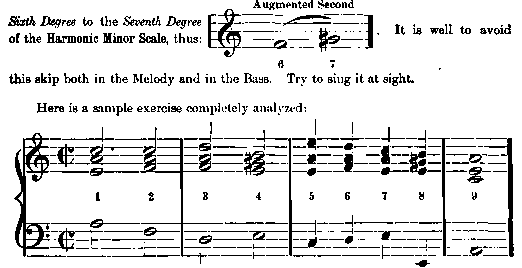Harmony Book For Beginners - online book
Scales, Intervals, Common Chords, Dominant Seventh Chord and Melody Making.
| Share page | Visit Us On FB |
|
HARMONY IN THE MINOR CONTINUED |
89 |
||
|
CHAPTER XXI
HARMONY IN THE MINOR CONTINUED
Bearing in mind all the working principles so far attained, the student is now ready to harmonize some exercisos in the Minor Scale.
The student will have noted that there is a skip of an Augmented Second from the |
|||
|
|
|||
 |
|||
|
1. The Tonic Chord, Third Position. Since the Signature is the same, both for the Major Scale and for its Relative Minor, the Tonic Chord (A Minor, in this case) tells us the Scale in which we are working.
2. The Submediant Chord, Fifth Position.
3. The Sub-Dominant Chord, Root Position.
4. The Dominant Chord, Fifth Position. This Chord also aids in settling the Scale in which we are working, since it contains (as its Third) the chromatically raised Seventh Degree or Leading Note. The Leading Note is very easy to harmonize, since it may always be treated as the Third of the Dominant Chord.
5. Tonic Chord, First Inversion (Fifth of the Chord doubled).
6. The Sub-Dominant Chord, Root Position.
7. The Tonic Chord, Second Inversion. This paves the way for the Perfect Cadence which follows (Chords 8 and 9).
8. The Dominant Chord, Fifth Position.
9. The Tonic Chord, Root Position.
Play and sing this Exercise. Note how smooth it is, how easily the Bass moves.
The above Analysis must be studied out, slowly and carefully, chord by chord. It tells some facts of the utmost importance.
Let the student write out an analysis of the next exercise, in the space provided below it. Give the Name of each Chord, its Position or Inversion. To begin with, tell in what Scale it is written. |
|||